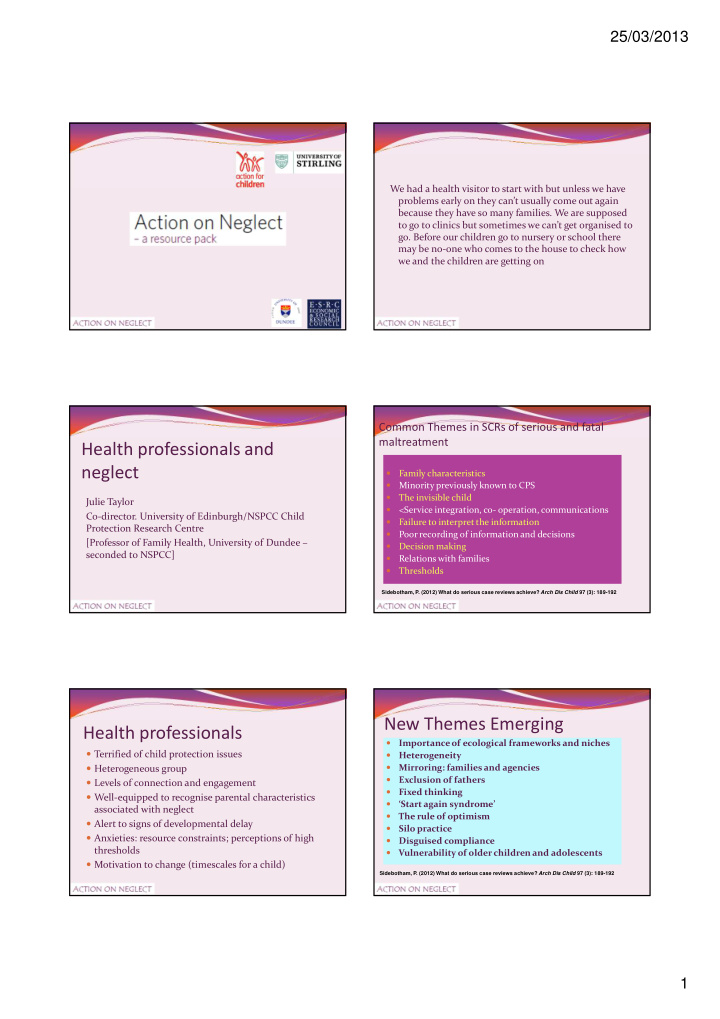



25/03/2013 We had a health visitor to start with but unless we have problems early on they can’t usually come out again because they have so many families. We are supposed to go to clinics but sometimes we can’t get organised to go. Before our children go to nursery or school there may be no-one who comes to the house to check how we and the children are getting on Common Themes in SCRs of serious and fatal maltreatment Health professionals and neglect � Family characteristics � Minority previously known to CPS � The invisible child Julie Taylor � <Service integration, co- operation, communications Co-director. University of Edinburgh/NSPCC Child � Failure to interpret the information Protection Research Centre � Poor recording of information and decisions [Professor of Family Health, University of Dundee – � Decision making seconded to NSPCC] � Relations with families � Thresholds Sidebotham, P. (2012) What do serious case reviews achieve? Arch Dis Child 97 (3): 189-192 New Themes Emerging Health professionals � Importance of ecological frameworks and niches � Terrified of child protection issues � Heterogeneity � Mirroring: families and agencies � Heterogeneous group � Exclusion of fathers � Levels of connection and engagement � Fixed thinking � Well-equipped to recognise parental characteristics � ‘Start again syndrome’ associated with neglect � The rule of optimism � Alert to signs of developmental delay � Silo practice � Anxieties: resource constraints; perceptions of high � Disguised compliance thresholds � Vulnerability of older children and adolescents � Motivation to change (timescales for a child) Sidebotham, P. (2012) What do serious case reviews achieve? Arch Dis Child 97 (3): 189-192 1
25/03/2013 High Profile Cases Adult Services High profile cases where children have died lend impetus to an escalating literature on resistance and disguised compliance within the child protection field. � GPs, mental health, addiction � Even if client is adult, they are still accountable for issues in relation to child Kyra Ishaq Peter Connolly � Data sharing isn’t that complicated Parents who are ‘hard to reach’ E.g. Burns Particular groups of parents who consistently fail to engage with professionals are likely to be labelled as � Average age for children burned as a result of neglect ‘hard to reach’. 2.7 years (2.1 physical abuse). � Mostly scalds Hard to reach parents might be perceived as difficult, � Most had been identified as at risk before accident, all obstructive and resistant. were returned home after Adults who abuse substances or have mental health � Neglected children – delayed seeking help; after-care difficulties do not always demonstrate rational � Burns would be deeper behaviour. Types of parents who may be defined as hard Is this child safe? to reach: � Resistant � In neglect this should be based on ‘is this good � Substance misuse enough’ rather than ‘is this as good as it can be’? � Travellers � Attendance at outpatients etc. � Some BME groups � Home schooling � Reconceptualise as ‘was not brought’ as opposed to ‘did not attend’ (Appleton and Powell 2012) � Rural isolation � Sectarianism � Disabled children � Etc etc etc � Domestic abuse is always significant � Record keeping is fundamental However, some might be willing to engage if services were more accessible � The therapeutic relationship � Parents can be devious. Not our job to be their friend 2
25/03/2013 E.g. School nurses � Passive and uninvolved � Active and firm Active and firm school nurses were not afraid of interfering and did not wait needlessly, expecting things to out right by themselves. Many of the nurses sent a letter to the child’s home or telephoned the family as problems arose. The school nurse might also ask the whole family to visit him or her; they showed interest in their clients and cared for him or her Solutions � Responsive pathways � Eg Vulnerable Cildren’s Teams – link from health services to Children’s Social Care for advice on individual families � Early Years provision � Family Nurse Patrnership � Enhanced health visitor services � Outreach from Children’s Centres 3
Recommend
More recommend